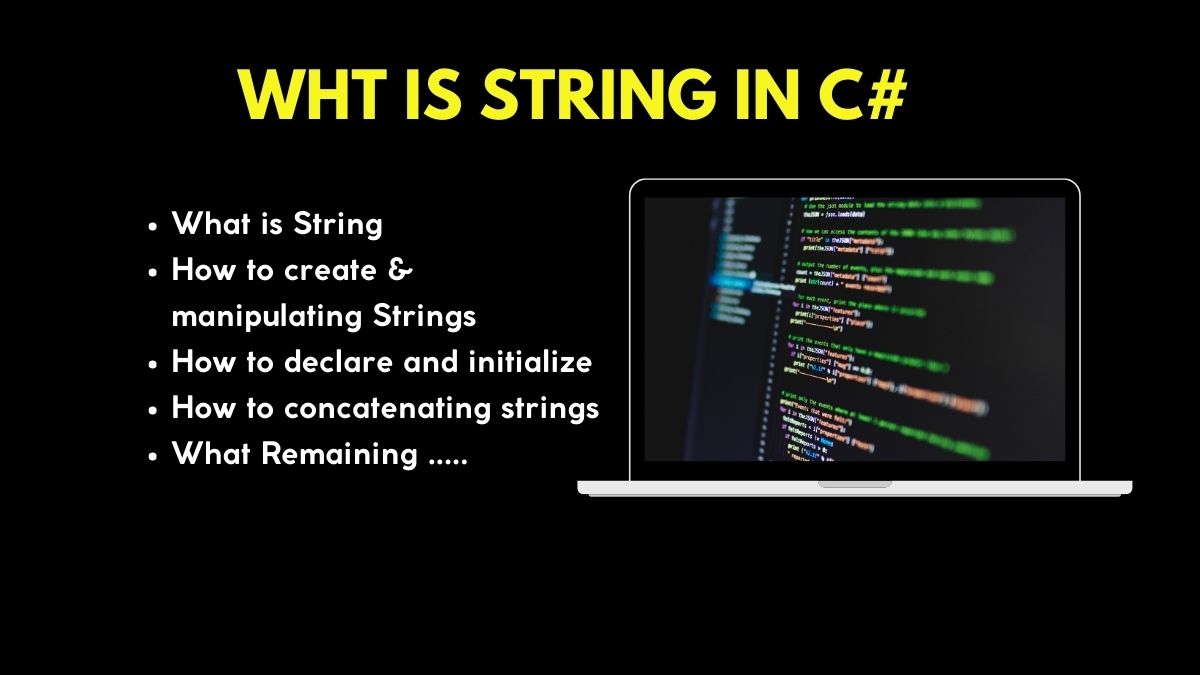C# is a versatile programming language used for developing a wide range of applications. One of the fundamental concepts in C# programming is the string. In this article, I will explain you what is a string in C Sharp, its importance, role of String in storing and manipulating text, how to create and manipulate strings, common string manipulation methods, string operations and comparisons, string formatting, best practices for string handling, and conclude with some frequently asked questions.
What is String in C Sharp ?
In C#, a string is a sequence of characters that represents text. It is a data type specifically designed for storing and manipulating textual data. Strings in C# are immutable, meaning that once created, they cannot be changed. However, it is possible to create new strings based on existing strings, which allows for string manipulation.
What is the Importance of String in C# programming?
Strings play a crucial role in C# programming. They are used for a variety of purposes, including handling user input, storing and retrieving data from databases, displaying messages to users, and manipulating textual data. Without strings, it would be challenging to work with textual information in C# applications.
Also Read: What is Type Casting in C# Programming
Role of String in storing and manipulating text?
Strings are the primary data type for storing and manipulating text in C#. They can store a single character or a sequence of characters. Textual data such as names, addresses, messages, and file paths can be stored in strings. String manipulation operations such as concatenation, substring extraction, searching, and replacing are commonly performed on strings.
How to creating and manipulating Strings?
To create a string in C#, you can use string literals or the string class constructor. String literals are enclosed in double quotes, such as “Hello, World!”. Here’s an example of creating a string using a string literal:
string message = "Hello, World!";
You can also create a string using the string class constructor:
string message = new string('A', 5);
In this example, a new string is created with five ‘A’ characters.
Also Read: How to Learn Data Types of C Sharp Programming
How to declaring and initializing a string variable?
To declare and initialize a string variable, you can use the following syntax:
string variableName = "initial value";
For example:
string name = "John";
In this example, a string variable named “name” is declared and initialized with the value “John”.
How to concatenating strings using the +operator?
In C#, you can concatenate strings using the + operator. The + operator combines two or more strings into a single string. Here’s an example:
string firstName = "John";
string lastName = "Doe";
string fullName = firstName + " " + lastName;
In this example, the variables “firstName” and “lastName” are concatenated with a space in between to create the “fullName” string.
Also Read: How to Learn the Basics of C Sharp Programming
What are the common string manipulation methods in C#?
C# provides a rich set of string manipulation methods that allow you to perform various operations on strings. Some of the commonly used methods include:
- Length: Returns the number of characters in a string.
- Substring: Extracts a portion of a string based on the specified start index and length.
- ToUpper and ToLower: Converts the string to uppercase or lowercase.
- Replace: Replaces occurrences of a specified substring with another substring.
- Split: Splits a string into an array of substrings based on a specified separator.
- Trim: Removes leading and trailing white space characters from the string.
Also Read: What is Computer Security and how to protect from attacks
String Operations and Comparisons:
C# provides various operations and comparisons that can be performed on strings. Some of the commonly used ones include:
Equality Comparison:
You can compare two strings for equality using the == operator. For example:
string str1 = "Hello";
string str2 = "World";
bool areEqual = (str1 == str2); // false
String Length:
The Length property allows you to retrieve the number of characters in a string. For example:
string message = "Hello, World!";
int length = message.Length; // 13
Substring Extraction:
The ‘Substring’ method allows you to extract a portion of a string. It takes two parameters: the starting index and the length of the substring. For example:
string message = "Hello, World!";
string substring = message.Substring(7, 5); // "World"
String Concatenation:
Besides using the ‘+’ operator, you can also use the ‘Concat’ method to concatenate strings. For example:
string str1 = "Hello";
string str2 = "World";
string combined = string.Concat(str1, ", ", str2); // "Hello, World"
String Formatting:
C# provides several ways to format strings. One commonly used method is ‘string.Format’, which allows you to insert values into a formatted string. For example:
string name = "John";
int age = 30;
string message = string.Format("My name is {0} and I'm {1} years old.", name, age);
// "My name is John and I'm 30 years old."
String Comparison:
You can compare strings using methods like ‘Compare’, ‘Equals’, and ‘CompareOrdinal’. These methods provide different comparison options, such as ignoring case or specifying culture-specific rules. For example:
string str1 = "apple";
string str2 = "Apple";
int result = string.Compare(str1, str2, StringComparison.OrdinalIgnoreCase); // 0
What is String Formatting in C#?
String formatting refers to the process of creating formatted strings by combining static text and dynamic values. C# provides the ‘string.Format’ method, which allows you to create formatted strings easily. Here’s an example:
string name = "John";
int age = 30;
string message = string.Format("My name is {0} and I'm {1} years old.", name, age);
In this example, the placeholders ‘{0}’ and ‘{1}’ are replaced with the values of ‘name’ and ‘age’, respectively. The resulting string will be “My name is John and I’m 30 years old.”
Best practices for String Handling
When working with strings in C#, it is important to follow some best practices to ensure efficient and reliable code. Here are some recommended practices for string handling:
- Use ‘StringBuilder’ for String Concatenation: If you need to concatenate multiple strings in a loop or a performance-critical scenario, it is more efficient to use the ‘StringBuilder’ ‘StringBuilder’ provides better performance and avoids unnecessary memory allocations.
- Be Mindful of String immutability: Remember that strings in C# are immutable. When performing string manipulation operations, such as concatenation or replacing, a new string is created. If you need to perform multiple string operations, consider using ‘StringBuilder’ or optimizing your code to minimize unnecessary string creation.
- Use String Interpolation: Instead of using ‘Format’, consider using string interpolation, denoted by the ‘$’ prefix. It allows you to directly embed expressions within the string without the need for placeholders.
- Handle Null and Empty Strings: Always handle null and empty strings appropriately in your code. Use methods like ‘IsNullOrEmpty’ or ‘string.IsNullOrWhiteSpace’ to check for null or empty values before performing any string operations. This helps to avoid potential null reference exceptions or unexpected behavior.
- Consider Cultural and Case-Sensitive Comparisons: When performing string comparisons, be mindful of cultural and case-sensitive scenarios. Depending on the requirements of your application, you may need to specify the appropriate comparison options to ensure accurate results. Use methods like ‘Compare’ with the appropriate ‘StringComparison’ enum values to handle cultural or case sensitivity requirements.
- Use Proper Memory Management: Strings in C# are managed by the .NET runtime, but it’s still important to handle memory efficiently. Avoid unnecessary string allocations and releases. Dispose of any resources associated with strings, such as streams or readers, using the appropriate disposal patterns.
Conclusion
In C# programming, the string data type plays a crucial role in handling and manipulating textual information. Understanding how to create, manipulate, and format strings is essential for building robust and efficient applications. By following best practices and utilizing the rich set of string manipulation methods provided by C#, developers can effectively work with textual data and ensure code reliability.
FAQs
-
Can I modify a string once it is created in C#?
No, strings in C# are immutable, meaning they cannot be changed. However, you can create new strings based on existing ones.
-
How do I compare two strings in C#?
You can compare strings using the
==operator for equality comparison or theComparemethod for more advanced comparisons. -
What is the difference between ‘
string’and ‘StringBuilder’in C#?While ‘
string’is immutable, meaning it cannot be changed, ‘StringBuilder’provides mutable string manipulation capabilities, making it more efficient for concatenating multiple strings. -
How can I check if a string is null or empty in C#?
You can use the ‘
string.IsNullOrEmpty’or ‘string.IsNullOrWhiteSpace’methods to check for null or empty strings. -
What is string interpolation in C#?
String interpolation is a feature that allows you to embed expressions directly within a string using the ‘
$’prefix, eliminating the need for placeholders.



